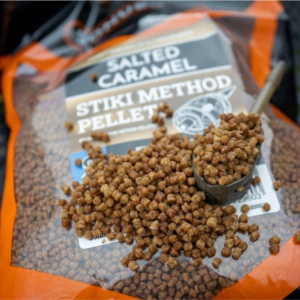An Essential Guide
Pellet baits are a cornerstone in the arsenal of many successful carp anglers. Their versatility, ease of use, and proven effectiveness make them a popular choice for both beginners and seasoned fishermen. In this article, we’ll delve into the various types of pellet baits, their benefits, and how to use them effectively to catch carp.
Types of Pellet Baits
Feed Pellets:
- Halibut Pellets: High in oil content, these pellets are incredibly attractive to carp due to their strong scent and rich nutritional value. They break down slowly, releasing a steady stream of attractants into the water.
- Trout Pellets: Another popular option, trout pellets are packed with proteins and oils. They vary in size and oil content, allowing anglers to choose based on water temperature and desired bait breakdown rate.
Hook Pellets:
- Soft Hook Pellets: These are designed to be directly hooked, offering convenience and a natural presentation. They are often pre-drilled or soft enough to be used with a baiting needle.
- Hard Hook Pellets: These pellets are durable and can be used with hair rigs. They are ideal for longer sessions as they withstand the attention of smaller fish and remain intact for extended periods.
Expander Pellets:
- Expander pellets start hard but soften when soaked in water, expanding in size. They can be used as hook baits or added to groundbait mixes, providing a versatile option for different fishing scenarios.
Benefits of Using Pellet Baits
Attraction:
- Pellets are designed to be highly attractive to carp. Their oil and protein content create a strong scent trail that draws carp from a distance.
- The breakdown of pellets releases a continuous stream of attractants, keeping carp interested and encouraging feeding.
Versatility:
- Pellets can be used in various ways: as loose feed, in PVA bags, as part of groundbait mixes, or directly on the hook.
- Their different sizes and types allow anglers to tailor their approach based on the fishing conditions and target carp behavior.
Ease of Use:
- Pellets are straightforward to prepare and use, making them accessible for anglers of all skill levels. Many pellets are pre-prepared and require minimal additional effort.
How to Use Pellet Baits Effectively
Pre-Soaking Pellets:
- Some pellets benefit from pre-soaking to soften them and enhance their attractiveness. For example, expander pellets need to be soaked until they achieve the desired consistency.
- Experiment with soaking times and liquid additives like fish oils, flavorings, or sweeteners to create a unique and highly attractive bait.
Loose Feeding and Groundbait Mixes:
- Loose feed pellets around your hook bait to create a feeding area that attracts carp. This technique works well when fishing over a bed of bait.
- Incorporate pellets into groundbait mixes to add texture and increase the nutritional value of the mix, encouraging prolonged feeding.
Using Pellets in PVA Bags:
- Fill PVA bags with pellets and other small particles to create a compact and attractive bait package. The PVA dissolves in water, releasing the pellets directly around your hook bait.
- This method ensures precise bait placement and is highly effective in drawing carp to your hook bait.
Hooking and Hair Rigging:
- Use soft hook pellets directly on the hook for a natural presentation. Alternatively, hard hook pellets can be drilled and mounted on hair rigs for a more durable setup.
- Ensure your rig is well-balanced to allow the bait to present naturally in the water, increasing the likelihood of a carp taking the bait.
Conclusion
Pellet baits are a highly effective and versatile option for carp fishing. Their strong attractant properties, ease of use, and adaptability make them a favorite among carp anglers. By understanding the different types of pellets and how to use them effectively, you can enhance your carp fishing strategy and increase your chances of landing those prized catches. Whether you’re a novice or an experienced angler, incorporating pellet baits into your fishing repertoire can lead to more successful and enjoyable fishing sessions.







